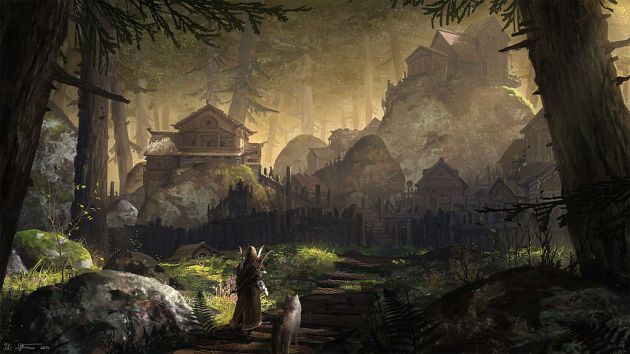Difference between revisions of "Hamlet"
Tao alexis (talk | contribs) |
Tao alexis (talk | contribs) |
||
| Line 4: | Line 4: | ||
Hamlets may be divided into two general groups: those that occur in [[Type-6 Hex|type-6 hexes]] and those that occur in [[Type-5 Hex|type-5]]. Thereafter, the chief distinction is the amount of water power available (does the hamlet's hex include a [[River|river]] large enough to drive a [[Gristmill|water mill]]) or whether or not the hamlet is located upon the sea or a large lake. In the latter case, the hamlet's significance is affected by the influence of currency rather than possessing a [[Barter Economy|barter economy]]. | Hamlets may be divided into two general groups: those that occur in [[Type-6 Hex|type-6 hexes]] and those that occur in [[Type-5 Hex|type-5]]. Thereafter, the chief distinction is the amount of water power available (does the hamlet's hex include a [[River|river]] large enough to drive a [[Gristmill|water mill]]) or whether or not the hamlet is located upon the sea or a large lake. In the latter case, the hamlet's significance is affected by the influence of currency rather than possessing a [[Barter Economy|barter economy]]. | ||
| − | Type-6 hamlets consist of | + | '''Type-6 hamlets''' consist of: |
| − | * [[Communal Hamlet|Communal hamlets]]: isolated, with residents sharing possessions and responsibilities. | + | * '''[[Communal Hamlet|Communal hamlets]]''': isolated, with residents sharing possessions and responsibilities. |
| − | * [[ | + | * '''[[Bailey Hamlet|Bailey hamlets]]''': also called "hamlet forts," noted for the presence of a surrounding wall and artisanal residents. |
| − | + | * '''[[Fishing Hamlet|Fishing hamlets]]''': located on bodies of water, with [[Catch Fishing (sage ability)|catch fishing]] supplanting farmland as the chief food supply. | |
| − | |||
| − | |||
| − | |||
| + | '''Type-5 hamlets''' consist of: | ||
| + | * '''[[Free Hamlet|Free hamlets]]''': cooperative loose communities occupied by freeholders possessing increased farmland and rights. | ||
| + | * '''[[Reeve Hamlet|Reeve hamlets]]''': also called "gallows hamlets," provincially regulated locales noted for the presence of a local official of the realm. | ||
| + | * '''[[Chartered Hamlet|Chartered hamlets]]: noted for the presence of a squire, serfs and free tenants. | ||
| + | With the exception of few serfs, hamlets are largely made up of peasants, or [[Commoner|commoners]], who are nominally free largely through indifference from the crown. These differ from freeholders, who possess deeds declaring the land they occupy to be theirs. The amount of freedom varies among the people, as does local administration. Little opportunity for trade and purchasing exists, though local products are available to outsiders with coin, while boat docks and way stations do provide additional wages for their operators. The basis of prosperity for most everyone is the production and transshipment of food, wood and stone. | ||
Revision as of 06:28, 3 January 2023
A hamlet is a group of rural dwellings that are too small to be considered a village, but possess an organisation that places them above thorps. Different forms of the hamlet occurs in different hexes, with distinct coin, bread and hammer signifiers. Hamlets do vary in size, leadership, defense, personal freedom and facilities offered, while retaining the quality of a trifling importance and humble nature. Any hamlet-dweller would see village life as exciting, fast-paced and a little terrifying.
Hamlets may be divided into two general groups: those that occur in type-6 hexes and those that occur in type-5. Thereafter, the chief distinction is the amount of water power available (does the hamlet's hex include a river large enough to drive a water mill) or whether or not the hamlet is located upon the sea or a large lake. In the latter case, the hamlet's significance is affected by the influence of currency rather than possessing a barter economy.
Type-6 hamlets consist of:
- Communal hamlets: isolated, with residents sharing possessions and responsibilities.
- Bailey hamlets: also called "hamlet forts," noted for the presence of a surrounding wall and artisanal residents.
- Fishing hamlets: located on bodies of water, with catch fishing supplanting farmland as the chief food supply.
Type-5 hamlets consist of:
- Free hamlets: cooperative loose communities occupied by freeholders possessing increased farmland and rights.
- Reeve hamlets: also called "gallows hamlets," provincially regulated locales noted for the presence of a local official of the realm.
- Chartered hamlets: noted for the presence of a squire, serfs and free tenants.
With the exception of few serfs, hamlets are largely made up of peasants, or commoners, who are nominally free largely through indifference from the crown. These differ from freeholders, who possess deeds declaring the land they occupy to be theirs. The amount of freedom varies among the people, as does local administration. Little opportunity for trade and purchasing exists, though local products are available to outsiders with coin, while boat docks and way stations do provide additional wages for their operators. The basis of prosperity for most everyone is the production and transshipment of food, wood and stone.
See also,
Coin (symbol)
The Adventure
